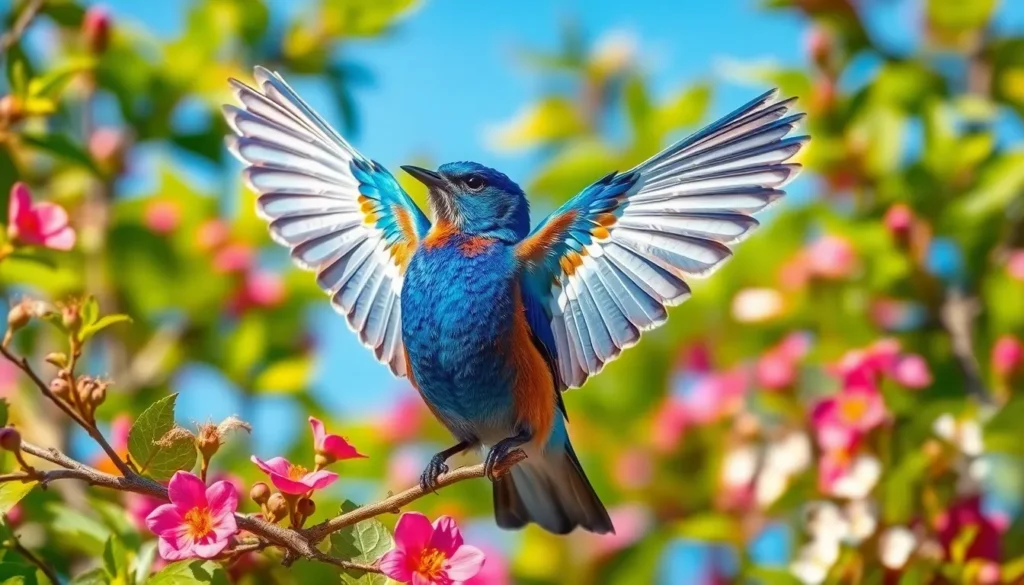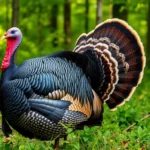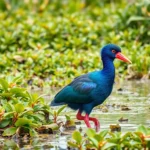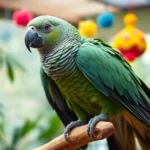We’ve all witnessed that breathtaking moment when a bird spreads its wings wide against the sky. Those magnificent displays of feathered architecture represent millions of years of evolutionary perfection designed for flight, display and survival.
Whether it’s a majestic eagle soaring overhead or a tiny hummingbird hovering at your feeder, birds’ open wings tell fascinating stories. From intricate courtship rituals to impressive territorial displays, these wing positions serve far more purposes than simple flight mechanics.
Understanding why birds open their wings reveals incredible insights into avian behavior, aerodynamics and adaptation strategies. We’ll explore the science behind wing positioning, decode common wing displays you’ve likely observed, and discover how different species use their wings for communication, thermoregulation and defense mechanisms that’ll change how you view your backyard visitors forever.
Understanding Bird Wing Anatomy and Structure
Bird wings represent one of nature’s most sophisticated engineering marvels, with each component serving exact aerodynamic and behavioral functions. We’ll explore the intricate feather systems that enable birds to achieve their remarkable wing displays and flight capabilities.
Primary Flight Feathers
Primary flight feathers form the wing’s outer edge and generate the majority of lift and thrust during flight. These 9 to 12 elongated feathers attach directly to the bird’s hand bones, creating the wing tip that cuts through air with precision. We observe that primaries display asymmetrical vanes, with the leading edge narrower than the trailing edge to reduce air turbulence.
Each primary feather can move independently, allowing birds to fine-tune their wing shape for different flight maneuvers or display behaviors. Raptors like hawks and eagles spread their primaries into distinctive “fingers” during soaring, maximizing lift efficiency. During courtship displays, many species fan their primaries wide to showcase colorful patterns or create impressive silhouettes that attract potential mates.
Secondary Flight Feathers
Secondary flight feathers line the inner portion of the wing and provide crucial lift support along the wing’s trailing edge. These feathers number between 6 and 40 depending on the species, with larger birds typically possessing more secondaries for enhanced wing surface area. We find that secondaries maintain more symmetrical vanes compared to primaries, optimizing them for steady lift generation rather than propulsion.
Waterbirds like ducks and swans rely heavily on their robust secondaries for takeoff power, as these feathers create the broad wing surface needed to lift heavy bodies from water. Many species molt their secondaries simultaneously, temporarily grounding them during this vulnerable period when new feathers develop.
Wing Coverts and Their Function
Wing coverts create smooth airflow over the wing surface by covering the gaps between flight feathers and the wing’s leading edge. These smaller, overlapping feathers number in the hundreds and arrange themselves in distinct rows called greater, median, and lesser coverts. We recognize coverts as essential for reducing drag and maintaining laminar airflow across the entire wing structure.
Lesser coverts position closest to the bird’s body and gradually transition in size toward the greater coverts near the flight feathers. This graduated arrangement eliminates sharp edges that would create turbulence during flight or wing displays. Coverts also play important roles in thermoregulation, as birds can adjust their position to trap warm air or release excess heat during temperature changes.
Identifying Different Wing Positions and Their Meanings

Understanding bird open wings behavior becomes clearer when we recognize the distinct positions birds adopt for different purposes. Each wing configuration sends exact messages and serves particular biological functions.
Full Wing Extension for Maximum Display
Maximum wing spread creates the most dramatic visual impact when birds communicate dominance or attract mates. We observe this behavior most commonly during territorial disputes where birds like eagles and hawks extend their wings completely to appear larger and more intimidating. Great blue herons demonstrate this position during courtship rituals, spreading their 6-foot wingspan to showcase their impressive size to potential partners.
Territorial birds use full extension to establish boundaries and warn intruders. Red-winged blackbirds perch on cattails with wings fully outstretched, revealing their bright red shoulder patches to signal ownership of prime nesting areas. Peacocks complement their famous tail displays with complete wing extension, creating a 360-degree spectacle that maximizes their visual presence during mating season.
Thermoregulation drives full wing extension in hot climates where birds need maximum cooling. Turkey vultures spread their wings wide while perched, using this “horaltic” pose to regulate body temperature and dry morning dew from their feathers. Cormorants adopt similar positions after diving, extending their less waterproof wings to dry and maintain proper insulation.
Partial Wing Opening for Balance
Moderate wing positioning helps birds maintain stability during challenging perching situations. We notice songbirds like robins and cardinals using slight wing extensions when landing on thin branches or dealing with windy conditions. This partial opening provides quick balance adjustments without the energy cost of full extension.
Feeding activities often require subtle wing movements for precise positioning. Woodpeckers demonstrate this behavior while foraging on tree trunks, using partial wing openings to brace themselves against vertical surfaces. Hummingbirds adjust their wing positions incrementally while hovering at flowers, making micro-adjustments to maintain perfect positioning for nectar access.
Social interactions within flocks involve measured wing displays that communicate without aggression. Chickadees and nuthatches use gentle wing movements to signal their approach to feeding areas, avoiding conflicts through subtle body language. These partial displays maintain flock harmony while establishing individual space requirements.
Asymmetrical Wing Positioning
Uneven wing positions typically indicate injury, illness, or exact behavioral responses to environmental factors. We should observe birds showing consistent asymmetrical positioning for potential health issues requiring wildlife rehabilitation assistance. Injured birds often favor one wing by keeping it slightly extended or held lower than the other.
Hunting and foraging behaviors sometimes create temporary asymmetrical wing displays. Raptors like kestrels use uneven wing positioning while hovering over prey, adjusting individual wings to compensate for wind currents and maintain hunting position. Shore birds walking along beaches may extend one wing slightly for balance while probing sand with their bills.
Environmental adaptations can produce asymmetrical wing positions during exact activities. Birds handling through dense vegetation may extend one wing more than the other to push through branches and maintain forward momentum. Cavity-nesting birds entering or exiting tight spaces often adjust wing positions independently to fit through openings efficiently.
Recognizing Common Reasons Birds Open Their Wings
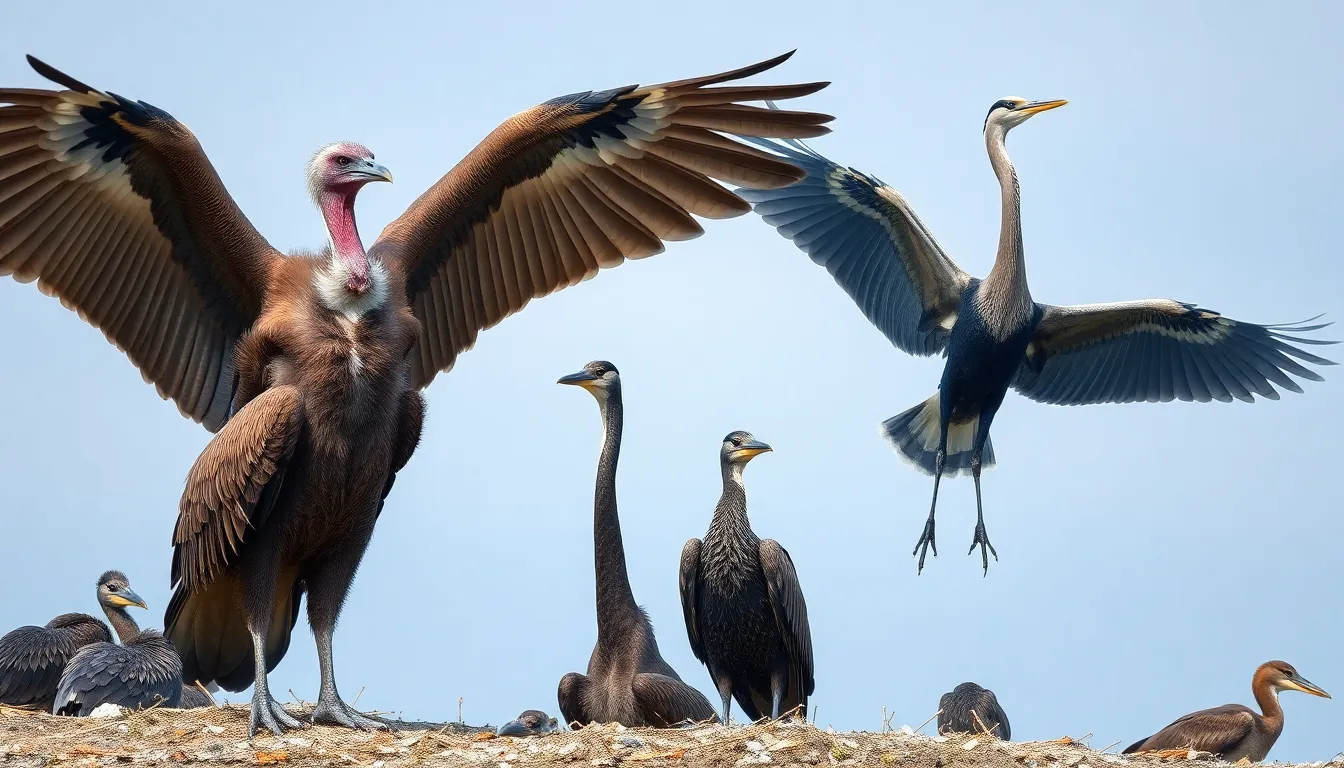
Understanding why birds spread their wings helps us decode their behavior and respond appropriately to what we observe in nature.
Thermoregulation and Temperature Control
Cooling down represents the most frequent reason we see birds opening their wings during hot weather. Birds spread their wings wide to increase surface area exposed to air currents, allowing heat to escape from their bodies more efficiently. Turkey vultures demonstrate this behavior perfectly as they soar with wings fully extended, using both flight dynamics and cooling mechanisms simultaneously.
Warming up occurs when birds position their wings to capture maximum sunlight during cooler periods. We notice this behavior most commonly in early morning hours when birds like cormorants and anhinga spread their wings perpendicular to their bodies, creating solar panels that absorb heat directly onto their dark feathers.
Panting accompanies wing spreading in many species during extreme heat conditions. Birds like roadrunners and quail combine rapid breathing with wing extension to maximize heat dissipation through both respiratory and surface cooling methods.
Drying Wings After Rain or Bathing
Water removal drives the distinctive wing drying posture we observe after birds get wet. Cormorants, pelicans, and other waterbirds spread their wings in a characteristic “scarecrow” position to allow air circulation around each feather, speeding the evaporation process significantly.
Feather maintenance becomes crucial after exposure to moisture, as wet feathers lose their insulating properties and flight efficiency. We see birds like ducks and geese performing wing flapping combined with spreading to shake off excess water and realign their feather structure properly.
Prevention of fungal growth motivates thorough drying behaviors in humid environments. Birds instinctively know that prolonged moisture can lead to feather damage and health issues, so they prioritize complete drying through extended wing displays.
Intimidation and Territorial Displays
Size enhancement serves as the primary intimidation strategy when birds open their wings during confrontations. Hawks, eagles, and owls spread their wings wide to appear larger and more threatening to potential rivals or predators, often doubling their perceived size instantly.
Warning signals accompany aggressive wing displays through exact postures and movements. We observe birds like great blue herons raising their wings high above their heads while simultaneously lowering their necks, creating an unmistakable threat display that communicates serious intent.
Territory establishment involves strategic wing positioning during breeding season disputes. Male red winged blackbirds perch prominently while spreading their wings to showcase their bright red shoulder patches, clearly marking their claimed territory boundaries to competing males.
Observing Wing-Opening Behaviors During Flight Preparation
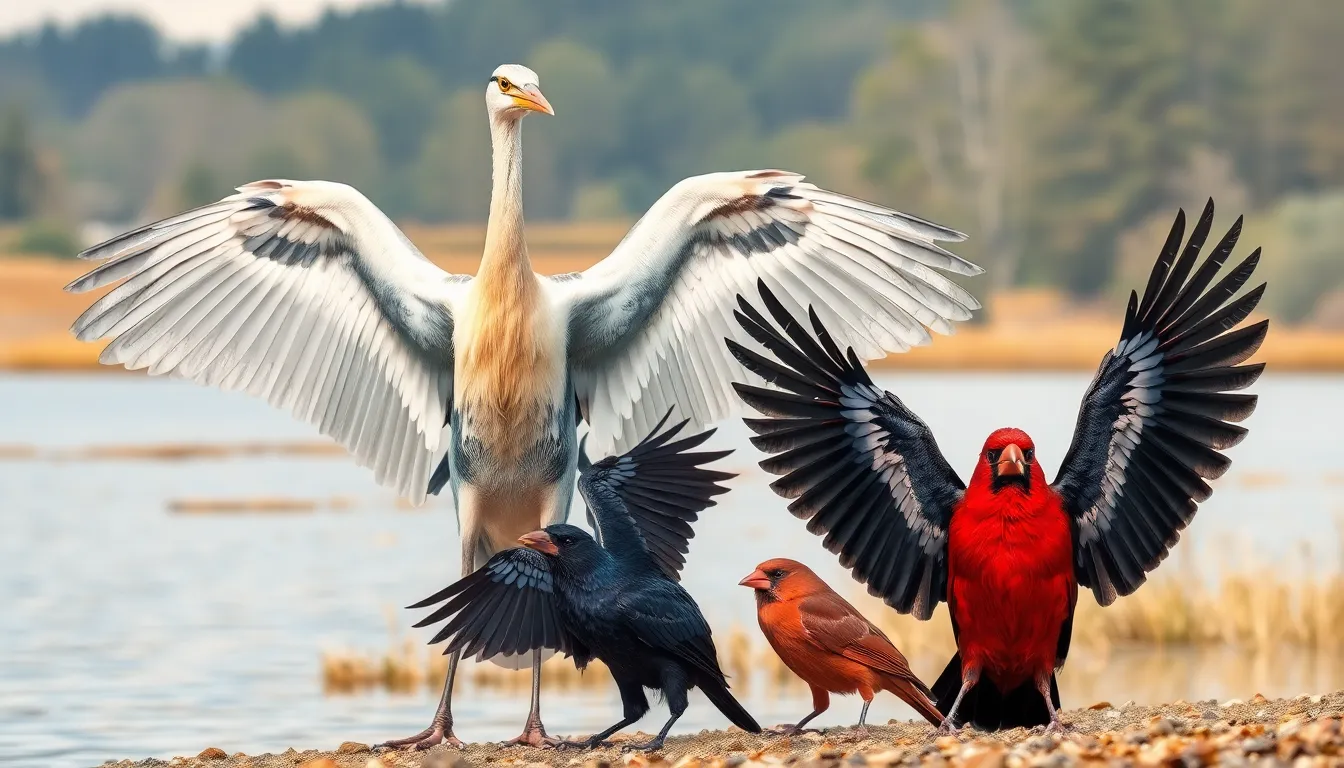
We can witness some of the most fascinating wing opening displays when birds prepare for flight. These preparatory behaviors reveal the intricate process birds use to ensure their wings are ready for takeoff.
Pre-Flight Wing Stretching Rituals
Pre-flight wing stretching helps birds activate their flight muscles and ensure proper feather alignment before takeoff. We observe birds like herons extending one wing fully while standing on shorelines, methodically working through each joint from shoulder to wingtip. Cardinals and blue jays perform bilateral stretches by opening both wings simultaneously above their backs, creating a distinctive arched position that loosens flight muscles.
Stretching behaviors also include rapid wing fluttering motions that increase blood flow to flight muscles. Robins demonstrate this by performing quick succession wing beats while perched, preparing their cardiovascular system for the demands of flight. Owls extend their wings in slow, deliberate movements during twilight hours, ensuring their silent flight feathers are properly positioned for hunting.
Testing Wind Conditions
Testing wind conditions allows birds to assess air currents and adjust their takeoff strategy accordingly. We notice gulls positioning themselves perpendicular to wind direction while partially extending their wings to gauge wind strength and stability. Crows perform similar assessments by lifting their wings slightly and feeling air resistance against their primary feathers.
Raptors like hawks demonstrate sophisticated wind testing by extending their wings at various angles to detect thermal currents. They’ll hold partial wing extensions for several seconds while rotating their heads to correlate visual cues with air movement patterns. Smaller birds like sparrows test wind by performing brief wing lifts that help them determine the optimal takeoff angle.
Wind assessment behaviors become more pronounced during adverse weather conditions when birds must evaluate whether flight conditions are safe for their species and body size.
Building Momentum for Takeoff
Building momentum for takeoff involves exact wing positioning sequences that generate the initial thrust needed for flight. We observe larger birds like geese performing several preliminary wing beats while still grounded, creating forward momentum before their feet leave the surface. Ducks demonstrate this behavior by combining rapid wing flaps with forward body movements on water surfaces.
Ground dwelling birds like pheasants use explosive wing opening patterns that generate maximum lift in minimal time. Their wings snap open with tremendous force while their legs simultaneously push off from the ground, creating a coordinated launch sequence. Smaller songbirds build momentum through rapid wing vibrations that appear almost hummingbird like before transitioning to full flight strokes.
Takeoff preparation also includes wing angle adjustments that optimize initial lift generation. Birds modify their wing positions based on their intended flight path, whether they’re launching vertically into trees or gliding horizontally across open spaces.
Documenting Seasonal Wing Display Patterns

Seasonal changes dramatically influence how birds use their wings throughout the year. We’ll examine three critical periods when wing display patterns shift significantly based on biological demands.
Mating Season Courtship Displays
Spring mating seasons trigger elaborate wing display behaviors that showcase each species’ unique courtship rituals. Male peacocks spread their massive tail coverts while simultaneously opening their wings to create stunning visual presentations that attract potential mates. Cardinals exhibit rapid wing fluttering combined with head bobbing as males court females during their March through August breeding period.
Elaborate dance sequences characterize many ground dwelling species during courtship rituals. Sandhill cranes perform intricate wing spreading ceremonies while jumping and calling to establish pair bonds. Wild turkeys display their wings in fan formations while strutting in circles around females during spring gobbling season.
Wing positioning varies significantly between species during these crucial mating displays. Hummingbirds create figure eight patterns with their wings to demonstrate their aerial prowess to potential partners. Red winged blackbirds spread their wings to reveal bright shoulder patches that signal their territorial claims and genetic fitness to females.
Molting Period Wing Exercises
Summer molting periods require careful wing maintenance as birds replace worn feathers with fresh plumage. During July and August most songbirds engage in frequent wing stretching exercises to maintain circulation while new feathers develop. Geese become temporarily flightless during their complete molt and compensate by increasing wing movement patterns while on water.
Partial wing extensions help birds assess their changing flight capabilities as molting progresses. Ducks test their wing strength through progressive flapping motions that gradually increase in intensity as new flight feathers emerge. Raptors like hawks and eagles perform cautious wing stretches to evaluate their hunting readiness during the 6 to 8 week molting process.
Recovery exercises become essential as birds regain full flight capacity after molting completion. Swallows engage in practice flights with exaggerated wing movements to rebuild muscle memory and coordination. Crows perform group flight exercises that include synchronized wing positioning to reestablish flock dynamics and communication patterns.
Migration Preparation Behaviors
Fall migration preparation triggers intensive wing conditioning behaviors as birds prepare for long distance journeys. Warblers increase their wing exercise frequency during August and September while building flight endurance for their upcoming transcontinental flights. Geese practice formation flying techniques that require precise wing coordination to maximize energy efficiency during their southern migrations.
Wing loading assessments help birds determine their readiness for extended flight periods. Shorebirds like sandpipers perform test flights along coastlines while adjusting their wing positions to evaluate their fuel reserves and flight capabilities. Ruby throated hummingbirds engage in hovering exercises that can last several minutes as they prepare for their 500 mile Gulf of Mexico crossing.
Strategic wing positioning during pre migration gatherings serves important social functions within flocks. Starlings demonstrate murmuration behaviors that require split second wing adjustments to maintain group cohesion. Canada geese establish flight hierarchies through wing displays that determine their positions in the classic V formation during their journey south.
Photographing Birds With Open Wings Successfully
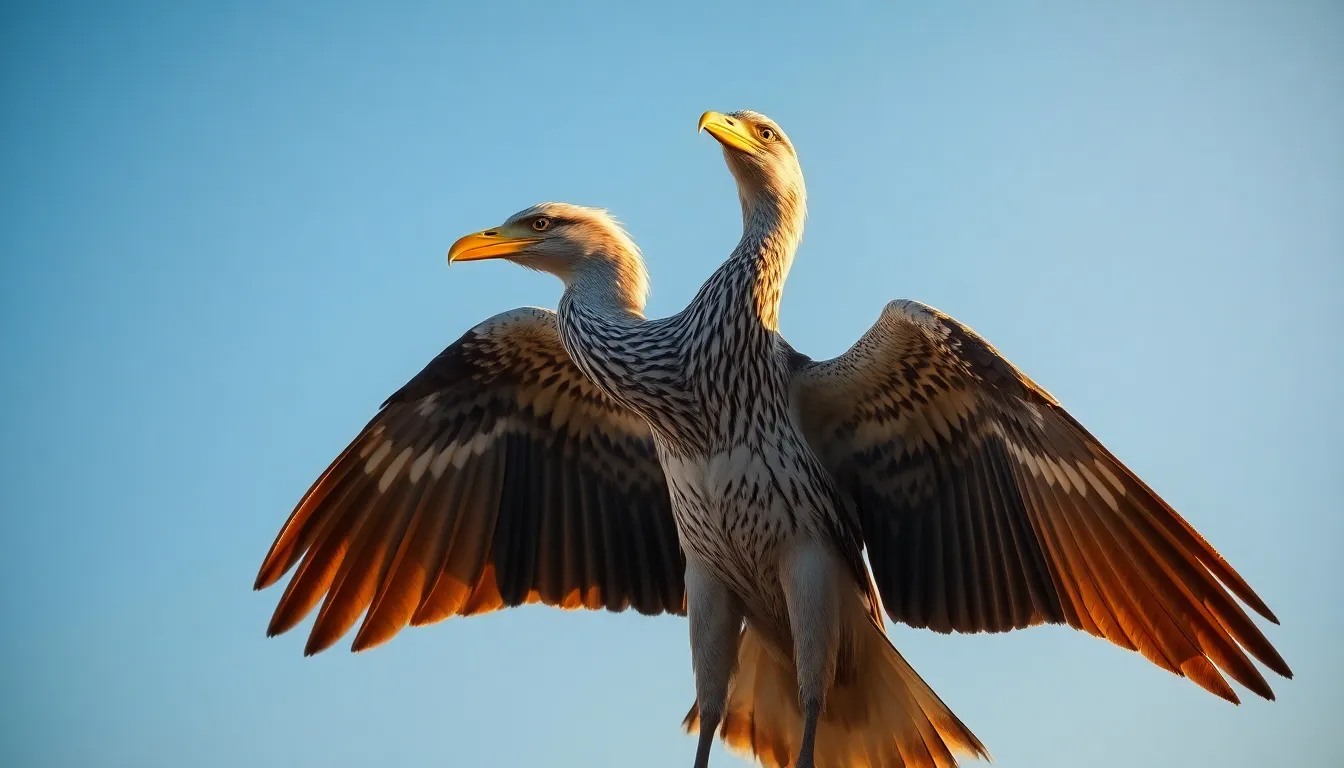
Capturing birds with their wings spread requires specialized techniques that account for rapid movements and precise timing. We’ll explore the essential camera settings, optimal conditions, and composition strategies that transform fleeting wing displays into stunning photographs.
Optimal Camera Settings for Wing Shots
Shutter speed becomes our most critical setting when photographing bird wing displays, requiring speeds of 1/1000th second or faster to freeze wing movement. Fast-moving species like hummingbirds demand even higher speeds of 1/4000th second, while larger birds such as herons and eagles can be captured effectively at 1/1600th second during their slower wing extensions.
Aperture settings between f/5.6 and f/8 provide the ideal balance of sufficient depth of field to keep the entire bird in focus while maintaining fast shutter speeds. We recommend avoiding apertures wider than f/4 as they can result in parts of the wing being out of focus, particularly during diagonal wing positions or when birds angle their bodies toward the camera.
ISO settings should remain as low as possible while still achieving proper exposure, typically ranging from 400 to 1600 in good lighting conditions. Modern cameras handle ISO 3200 effectively for early morning or late afternoon wing photography sessions, though we always prioritize maintaining detail in the wing feathers over reducing noise.
Continuous autofocus modes (AI Servo or AF-C) track moving birds more effectively than single-point focusing, especially during pre-flight wing stretching sequences. We set our cameras to back-button focus to maintain control over focus timing, preventing the camera from refocusing when birds pause their wing movements.
Best Timing and Lighting Conditions
Early morning hours between sunrise and 9 AM offer optimal lighting for wing photography, providing soft directional light that highlights feather details without creating harsh shadows. We’ve observed that many species engage in wing stretching behaviors during this period as they warm up and prepare for daily activities.
Golden hour lighting enhances wing translucency in species with lighter colored feathers, creating dramatic backlighting effects when birds position themselves between the photographer and the sun. Cardinals, robins, and other songbirds appear particularly striking during these conditions, with their wing feathers glowing against darker backgrounds.
Overcast conditions provide even illumination that reduces contrast between light and dark wing areas, making exposure calculations more manageable. We find these conditions especially beneficial for photographing darker birds like crows or ravens, where bright sunlight can obscure wing detail in shadows.
Wind conditions significantly influence wing photography opportunities, as birds frequently adjust their wing positions to test air currents before flight. We position ourselves upwind from likely perching spots, allowing birds to face into the wind and naturally spread their wings during takeoff preparations.
Composition Techniques for Ever-changing Images
Rule of thirds placement positions the bird’s body along the intersecting lines rather than centering it, creating more ever-changing compositions that emphasize wing span. We place the bird’s eye at one of the intersection points, allowing the extended wings to flow naturally across the frame.
Negative space around extended wings prevents cramped compositions and allows the full wing display to breathe within the frame. We leave approximately one-third of the frame empty on the side toward which the bird faces, creating visual flow and emphasizing the direction of potential movement.
Low shooting angles capture wing displays from below, creating dramatic perspectives that showcase the full wingspan against sky backgrounds. This technique works particularly well with larger birds like herons, egrets, and raptors during their territorial displays or thermoregulation behaviors.
Burst mode photography captures the complete wing movement sequence, from initial extension through full spread and back to resting position. We select the frame showing peak wing extension while maintaining sharp focus on critical areas like the bird’s eye and primary flight feathers.
Background separation techniques isolate the subject from cluttered environments, using telephoto lenses to compress depth and create smooth, out-of-focus backgrounds. We position ourselves to place water, sky, or distant vegetation behind wing-displaying birds, ensuring the intricate feather patterns remain the focal point of our compositions.
Distinguishing Wing Displays Across Different Bird Species
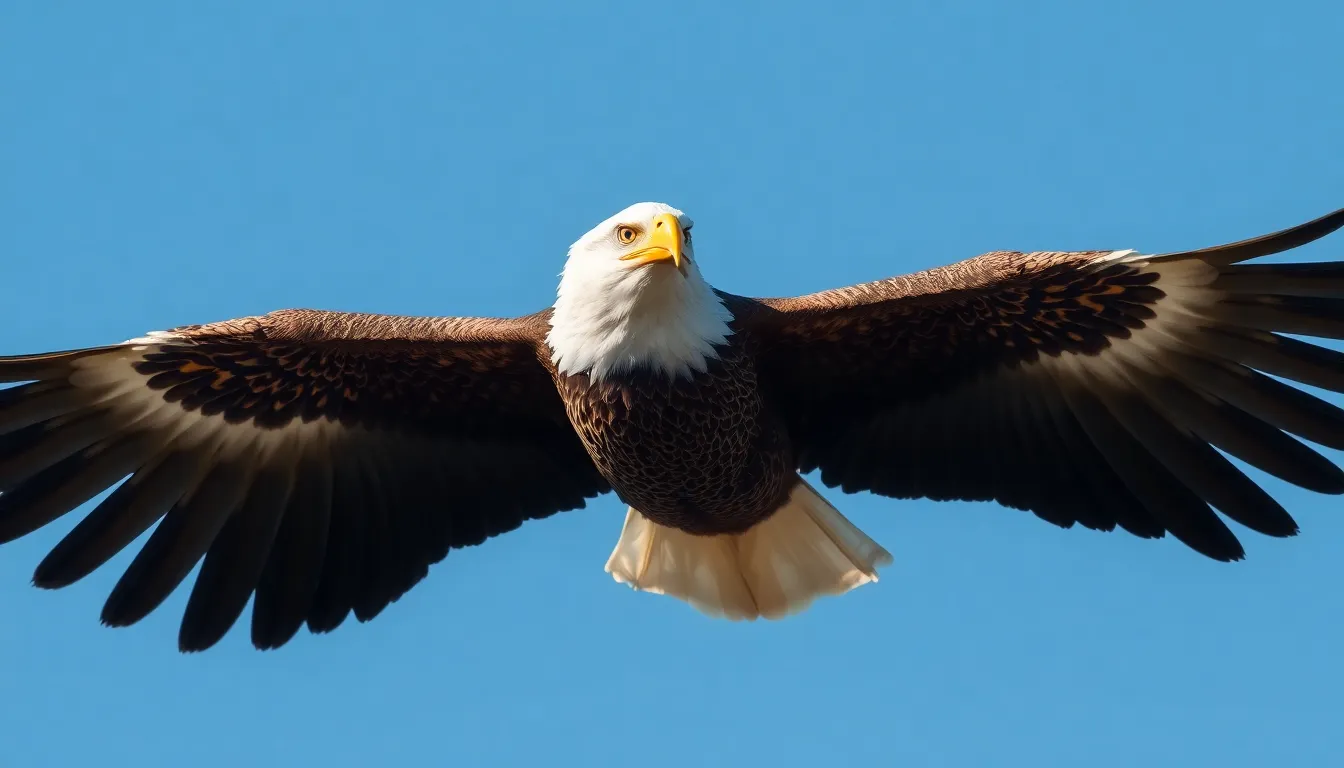
Different bird species have evolved unique wing display patterns that reflect their exact ecological niches and behavioral needs. Understanding these variations helps us identify birds more accurately and appreciate the diversity of avian communication methods.
Raptors and Their Intimidating Wing Spreads
Raptors use wing displays as powerful intimidation tools that emphasize their predatory dominance. Hawks spread their wings wide with feathers fully extended while perching on prominent branches or fence posts. This positioning creates an imposing silhouette that warns competitors and potential threats to maintain distance from their hunting territories.
Eagles demonstrate the most dramatic wing displays among raptors with spans reaching 6 to 8 feet in species like bald eagles and golden eagles. We observe these magnificent birds opening their wings completely during territorial disputes and when establishing dominance over feeding sites. The wing positioning also serves practical purposes as eagles use thermal currents more effectively with fully extended wings.
Falcons exhibit different wing display behaviors that reflect their high speed hunting strategies. Peregrine falcons often display partially opened wings while scanning for prey from elevated perches. Their wing positioning allows for rapid takeoff and immediate pursuit of target birds.
Owls present unique wing displays that differ significantly from diurnal raptors. Great horned owls and barn owls spread their wings forward and downward when threatened, creating a defensive umbrella shape that makes them appear larger and more menacing to potential predators.
Waterbirds and Their Drying Techniques
Waterbirds have developed specialized wing drying behaviors that address the challenges of their aquatic lifestyle. Cormorants are perhaps the most recognizable practitioners of wing drying displays as they perch with wings fully extended in a characteristic crucifix position. This behavior allows water to evaporate from their less waterproof feathers while also helping to realign flight feathers for optimal aerodynamics.
Pelicans engage in similar drying rituals but incorporate additional movements that enhance the drying process. Brown pelicans and white pelicans shake their wings periodically while holding them open, accelerating water removal and preventing feather damage from prolonged moisture exposure.
Ducks and geese demonstrate different drying approaches that suit their more waterproof plumage. Mallards and Canada geese typically engage in wing flapping sequences rather than static displays, beating their wings rapidly while remaining on the water surface or shoreline.
Herons and egrets combine drying behaviors with stretching routines that maintain feather condition. Great blue herons extend one wing at a time in elegant stretching motions that serve both drying and maintenance functions. These displays often occur in early morning hours when dew and overnight moisture need to be removed from their plumage.
Songbirds and Their Courtship Displays
Songbirds showcase remarkable diversity in courtship wing displays that complement their vocal performances. Cardinals demonstrate vibrant red wing flashes during mating season as males spread their wings while singing from prominent perches. The wing positioning enhances their colorful plumage and creates visual emphasis for their territorial songs.
Robins perform elaborate wing quivering displays during courtship rituals that signal their readiness to mate. Male robins approach potential mates with slightly opened wings that vibrate rapidly while they hop and sing. This behavior creates both visual and auditory signals that attract female attention.
Warblers exhibit subtle but meaningful wing displays that vary significantly between species. Yellow warblers flutter their wings in quick bursts during courtship, while black throated blue warblers incorporate wing positioning into complex dance like movements.
Finches demonstrate group courtship behaviors that include synchronized wing displays. House finches and goldfinches often engage in communal displays where multiple males perform wing opening sequences while competing for female attention. These displays create ever-changing visual performances that showcase the health and vigor of potential mates.
Sparrows use more understated wing displays that emphasize precision over drama. Song sparrows and white throated sparrows incorporate subtle wing positioning into their territorial displays, using quick wing flicks and partial extensions to communicate with rivals and potential mates.
Creating Optimal Conditions for Wing-Opening Observations
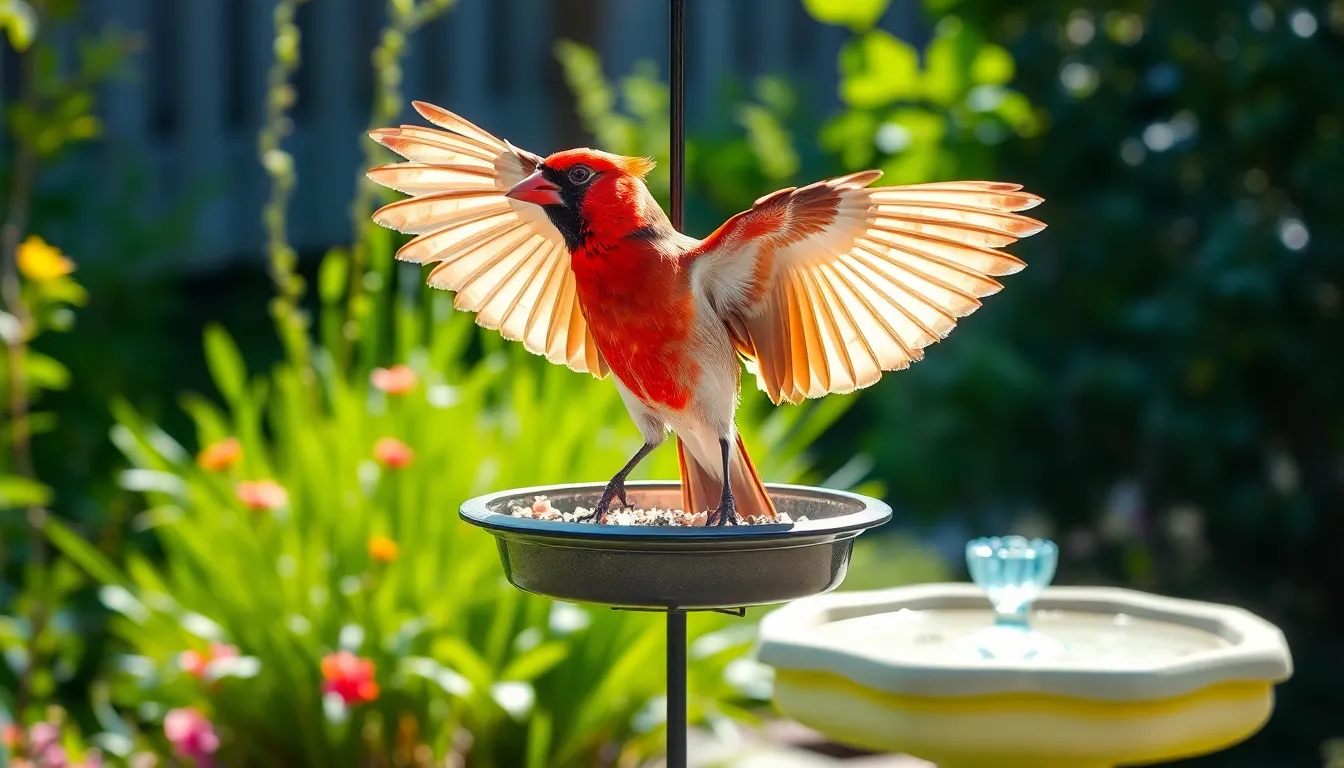
We can dramatically increase our chances of witnessing wing displays by establishing environments that naturally encourage these behaviors.
Setting Up Feeding Stations
Platform feeders positioned 3-4 feet from the ground create ideal opportunities for observing balance-related wing movements. Cardinals, blue jays, and mourning doves frequently extend their wings while feeding on these elevated surfaces, especially during windy conditions. Tube feeders placed near open areas allow us to witness pre-flight wing stretching as birds prepare to leave after feeding.
Ground feeding stations scattered with millet, cracked corn, and sunflower seeds attract species like sparrows and juncos that display territorial wing positions during competitive feeding. We’ll observe more wing displays by maintaining multiple feeding areas 10-15 feet apart, reducing overcrowding and encouraging natural spacing behaviors.
Suet feeders mounted on tree trunks create vertical feeding opportunities where woodpeckers, nuthatches, and chickadees showcase their wing balancing techniques. Position these feeders where morning sunlight can illuminate wing details while birds feed and display.
Provide Water Sources
Shallow birdbaths with depths ranging from 1-3 inches trigger extensive post-bathing wing displays as birds dry and preen their feathers. We’ll witness the most dramatic wing opening behaviors within 15-30 minutes after birds bathe, when they spread wings wide to help drying.
Dripping water features create irresistible attractions that draw birds into prolonged bathing sessions. The sound of moving water encourages extended visits, increasing our opportunities to observe the complete sequence of bathing, wing shaking, and drying behaviors. Installing drippers or small fountains near viewing areas ensures consistent wing display activity.
Multiple water depths accommodate different species’ preferences and behaviors. Robins prefer deeper areas for full body bathing and vigorous wing splashing, while smaller songbirds favor shallow edges for quick dips and immediate wing displays.
Choosing Strategic Viewing Locations
Windows facing southeast provide optimal morning lighting conditions that illuminate wing details during peak activity periods between 6-10 AM. We can observe thermoregulation behaviors as birds position themselves to catch warming sunlight, often spreading wings to absorb maximum heat.
Elevated observation points such as second-story windows or raised decks offer superior viewing angles for documenting full wing extension displays. These positions allow us to see wing patterns and movements that remain hidden from ground-level observation.
Protected viewing areas with screens or blinds prevent our presence from disrupting natural wing behaviors. Birds display more authentic behaviors when they feel secure, particularly during territorial disputes and courtship activities that involve elaborate wing positioning.
Open lawn spaces adjacent to feeding and water sources create natural stages where birds perform pre-flight wing preparations and territorial displays. These clear areas provide unobstructed views of wing movements while offering birds the security of nearby escape routes into shrubs or trees.
Conclusion
The intricate industry of bird wing displays reveals nature’s remarkable engineering and communication systems. We’ve explored how these magnificent structures serve far more than flight alone – they’re sophisticated tools for thermoregulation courtship territorial defense and social interaction.
Understanding these behaviors enriches our connection with the natural industry around us. Whether we’re observing a cardinal’s courtship dance or watching a cormorant dry its wings after diving we’re witnessing millions of years of evolutionary refinement in action.
By creating bird-friendly environments with feeding stations water sources and strategic observation points we can encourage these captivating displays in our own backyards. Every opened wing tells a story of survival adaptation and the endless wonders of avian life that continue to inspire and amaze us.
Frequently Asked Questions
Why do birds open their wings when they’re not flying?
Birds open their wings for multiple reasons including thermoregulation (cooling down or warming up), drying feathers after bathing or rain, intimidation displays to ward off threats, territorial marking during breeding season, and courtship rituals to attract mates. These behaviors are essential forms of avian communication and survival strategies.
What does it mean when a bird spreads both wings fully?
Full wing extension typically indicates maximum display behavior used during courtship rituals, territorial disputes, or intimidation tactics. Birds like eagles and peacocks use this position to appear larger and more impressive. It can also help with thermoregulation, allowing birds to capture sunlight or release excess heat.
How can I tell if a bird is preparing for flight by its wing position?
Pre-flight birds often engage in wing stretching exercises, test wind conditions by adjusting wing angles, and perform preliminary wing beats to build momentum. You’ll notice deliberate wing movements, muscle activation stretches, and assessment behaviors as they gauge air currents before takeoff.
What camera settings work best for photographing birds with open wings?
Use fast shutter speeds of 1/1000th second or faster to freeze wing movement, aperture settings between f/5.6 and f/8 for proper depth of field, and low ISO settings for optimal exposure. Shoot in burst mode during early morning or golden hour for the best lighting conditions.
Do different bird species have unique wing display patterns?
Yes, each species has evolved distinct wing display behaviors. Raptors use intimidating spreads for dominance, waterbirds have specialized drying techniques, owls adopt defensive postures, and songbirds exhibit diverse courtship displays. These patterns reflect their specific ecological niches and behavioral needs.
How can I encourage birds to display their wings in my backyard?
Set up feeding stations at various heights, provide water sources like birdbaths with dripping features, and create strategic viewing areas. These elements naturally encourage wing movements during feeding, trigger post-bathing displays, and provide optimal observation opportunities for witnessing natural wing behaviors.
What’s the difference between primary and secondary flight feathers in wing displays?
Primary flight feathers, located at wing tips, generate lift and thrust while creating dramatic display effects. Secondary flight feathers provide lift support and contribute to the wing’s overall shape during displays. Together, they allow birds to fine-tune their wing positioning for various behavioral and aerodynamic purposes.
When is the best time of year to observe wing displays?
Wing displays vary seasonally. Spring brings elaborate courtship displays, summer features thermoregulation behaviors, molting periods show maintenance stretches, and fall migration seasons intensify wing conditioning exercises. Each season offers unique opportunities to observe different types of wing-related behaviors.

